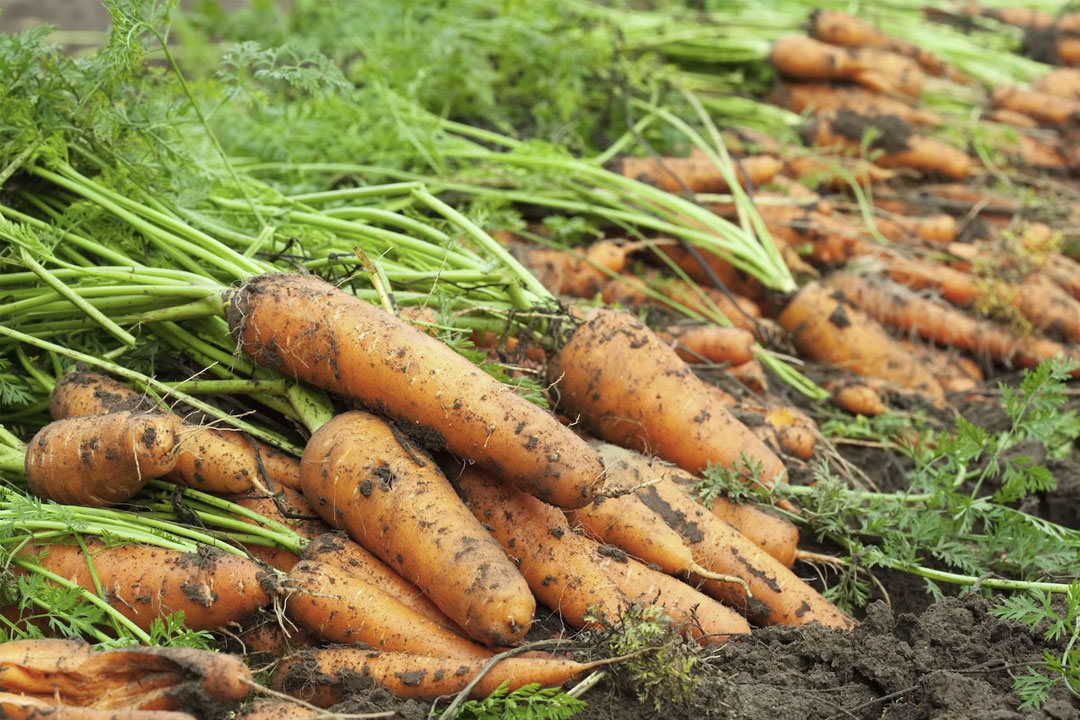
- CLIMATIC REQUIREMENTS: Carrots grow best under cool conditions (10° to 25°C) with regular uninterrupted growth. The optimal temperature for growth is between 15° to 20°C. Poorer color develops at temperatures below or above the optimum.
- SOIL REQUIREMENTS: Carrots grow well in deep, well-drained, sandy loam soils with a friable texture. Heavy, stony, compacted, and poorly drained soil is less desirable as it interferes with the development of roots. Carrots do not grow well in acid soils below a pH of 5. A pH of 6.5 to 7.0 is ideal for carrot production. Carrots are also very sensitive to saline soils, and brackish soils should be avoided.
- PRODUCT TYPES: Different types of carrots include Imperator, Nantes, Amsterdam or Miniature, and Kuroda.
- SOIL PREPARATION: Thoroughly prepare the soil, with a level, fine, soil surface. Deep ploughing or working to loosen the soil to a depth of at least 30 cm is important to allow good root development. It is preferable that soil be raised and bedded to obtain optimum drainage and soil depth to maximize root length and smoothness.
- PLANTING PERIODS: Sowing carrots is influenced by varietal differences and geographic location. Generalized sowing dates for carrots in South Africa are as follows:
- Cold areas (heavy frosts): August to February
- Warm areas (light frosts): March to July
- Hot areas (no frost): March to August
- SOWING: The ideal plant population depends on the type of carrot being grown.
- For larger, processing type carrots: 600,000 to 900,000 plants per hectare
- For standard pre-pack sized carrots: 900,000 to 1,500,000 plants per hectare
- For Imperators/baby carrots: 2,000,000 to 3,500,000 plants per hectare
- PLANTING DEPTH: The ideal planting depth is between 0.5 cm and 1.5 cm.
- FERTILIZATION: It is recommended that a soil and water analysis be done prior to planting carrots. This will ensure that all factors, including pH, are taken into account, thereby reducing fertilizer waste and eliminating the risk of oversupply and possible risk of fertilizer burn of the crop.
- Nitrogen: On mineral/ sandy loam soils, apply 150 – 200 kg N/ha, split into two to three equal applications.
- Phosphorus: Apply 100 – 200 kg P/ha as a basal dressing on low P soils.
- Potassium: Apply 100 – 200 kg K/ha as a basal dressing.
- IRRIGATION: Carrots require consistent moisture to grow well. The soil should be moist but not waterlogged. Irrigation can be done using drip or overhead irrigation.
- PEST AND DISEASE MANAGEMENT: Common pests and diseases that affect carrot production include carrot fly, leaf blight, and nematodes. Practice crop rotation, weed management, and use of certified disease-free seeds to minimize the risk of pest and disease infestations.
- HARVESTING: Harvesting should be done when the carrots have reached their optimal size and color. Pull the carrots out of the ground, and cut off the foliage. Avoid bruising or damaging the carrots during harvest.
- STORAGE: Carrots can be stored for several months if they are kept in a cool, humid, and dark environment.
In conclusion, carrot production requires careful attention to climatic and soil requirements, as well as specific cultivation practices such as soil preparation, planting periods, and fertilization. Proper planning and management can result in high yields of straight, smooth roots in different varieties such as Imperator, Nantes, Amsterdam, and Kuroda. Growers should strive to maintain optimal conditions for growth and development, while also monitoring plant populations and addressing any issues that may arise. With these steps in mind, growers can successfully produce high-quality carrots for various markets and uses.


















